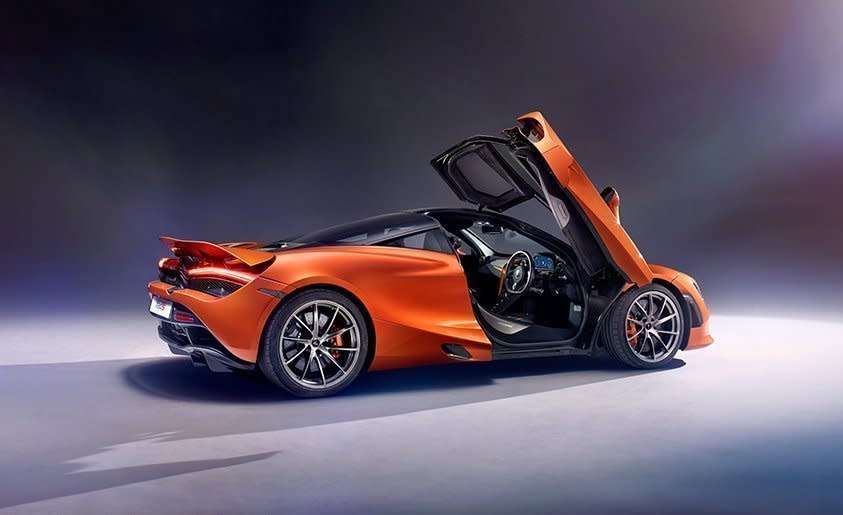2018 McLaren 720S Dissected: Chassis, Powertrain, Styling, and More!


From the May 2017 issue
McLaren marches to a speedy techno drumbeat. It’s been only six years since the company’s supercar-making Automotive division launched its first product, the MP4-12C. McLaren gave that car what was essentially a heavy facelift—and a far less clunky name—just three years later, rechristening it the 650S. Now the mostly new 720S is here, based around a substantially advanced version of the 650S’s carbon-fiber tub and a turned-up-to-11 twin-turbocharged V-8 mounted amidships. McLaren, a brand we don’t associate with hyperbole, claims on-track performance will make that of the 650S feel almost leisurely. Certainly looks that way.
Chassis
McLaren has stuck with commendable adhesion to the plan it announced when it launched its road-car division back in 2010. That is, to use the same core architecture to create a family of models graded thusly: entry-level “Sports,” mid-ranking “Super,” and extreme “Ultimate” series. The 720S coupe is the first of the second-generation Super Series cars, and as such brings forth a new iteration of the company’s carbon-fiber tub. The so-called Monocage II is more robust than the MonoCell of the 650S, incorporating an upper structure that integrates the windshield framework, the roof spar, B-pillar hoop, and buttresses. The upper A-pillars’ moldings are sufficiently well finished that they don’t need interior cladding. The roof spar includes attachments for the new wider-opening dihedral doors. The tub weighs 39 pounds less than the old MonoCell, with the car’s overall weight falling to a claimed 2829 pounds.

That's no photographic trick. Red lights that illuminate the engine bay when the 720S is unlocked are standard equipment.
At lower speeds, the acceleration numbers aren’t much better than those for the 650S, which was already operating at the outer edge of the traction envelope. McLaren claims a 2.8-second 60-mph time for the 720S, just a tenth quicker than its claim for the 650S. But as speed builds, so do the differences, with the 720S hitting 124 mph (200 km/h) in 7.8 seconds—0.6 second quicker—and 186 mph (300 km/h) in just 21.4 seconds, a whopping four seconds sooner. The claimed top speed is 212 mph.
Styling
The 720S looks stunning, but it also looks different—not just from the McLaren road cars that have preceded it, but also from pretty much every other mid-engined supercar. Here’s why: There’s no obvious intake behind the door. “As soon as we set the aerodynamic targets for this car, we realized we could not use an intake there,” says Haydn Baker, vehicle line director. “That was the challenge from day one.”

The instrument panel's track mode suggests that McLaren isn't worried about coolant or oil temps. And it must expect that your rib cage will wear out faster than the fuel tank will run dry.
Interior
The cabin feels more spacious than the 650S’s, thanks in large part to how much easier it is to enter. As noted, the top-hinged doors open wider than the old car’s dihedral doors and the sills are narrower. Once you’re inside, the slimmer carbon A-pillars dramatically improve forward visibility. Design details include a TFT instrument cluster that tucks down into the dashboard to reduce driver distraction when the car is in track mode, displaying only the speed, the selected gear, and a minimalist tach.

Housekeeping
We’ll have to wait until closer to the June on-sale date to confirm pricing, but the buzz from inside McLaren is that the 720S will cost around $285,000 in the unoptioned state that nobody is likely to buy it in. A Spider version will follow by 2019 and is certain to be the more popular choice. (More than a whopping 80 percent of 650S sales in the U.S. were of the open-topper.) An even faster LT variant is also a certainty. Don’t expect to wait long for that one, either, as McLaren’s techno pulse throbs on.

ON THE WING OF LOVE
Compared with its counterpart on the 650S, the 720S’s deployable rear wing is a win-win-win. When extended, it contributes to a doubling of downforce over the 650S. Stowed, it reduces drag. But our favorite feature is the fact that the wing—and, indeed, the whole car—appears to have been styled by someone with a sense of aesthetics.

 Yahoo Finance
Yahoo Finance 